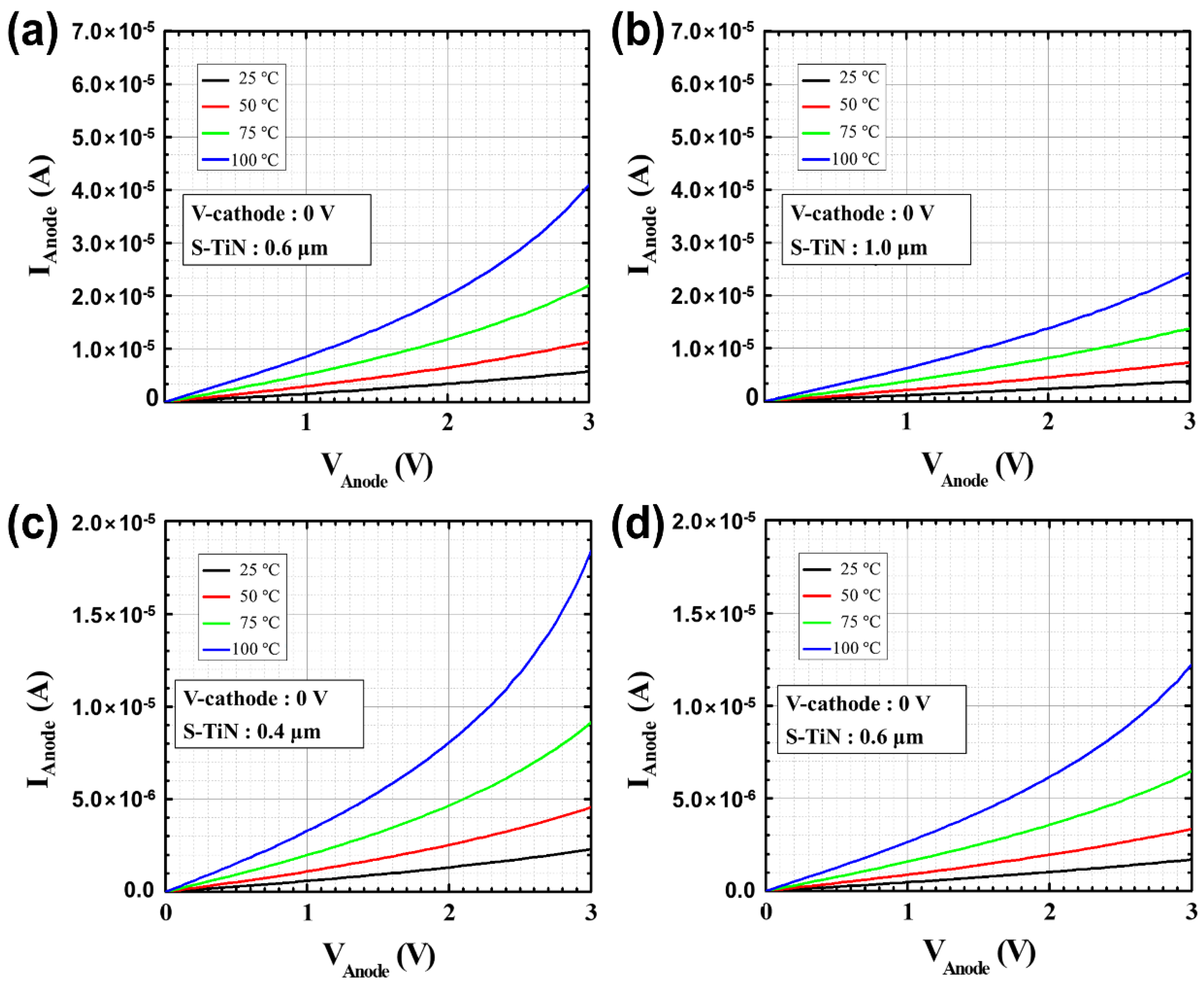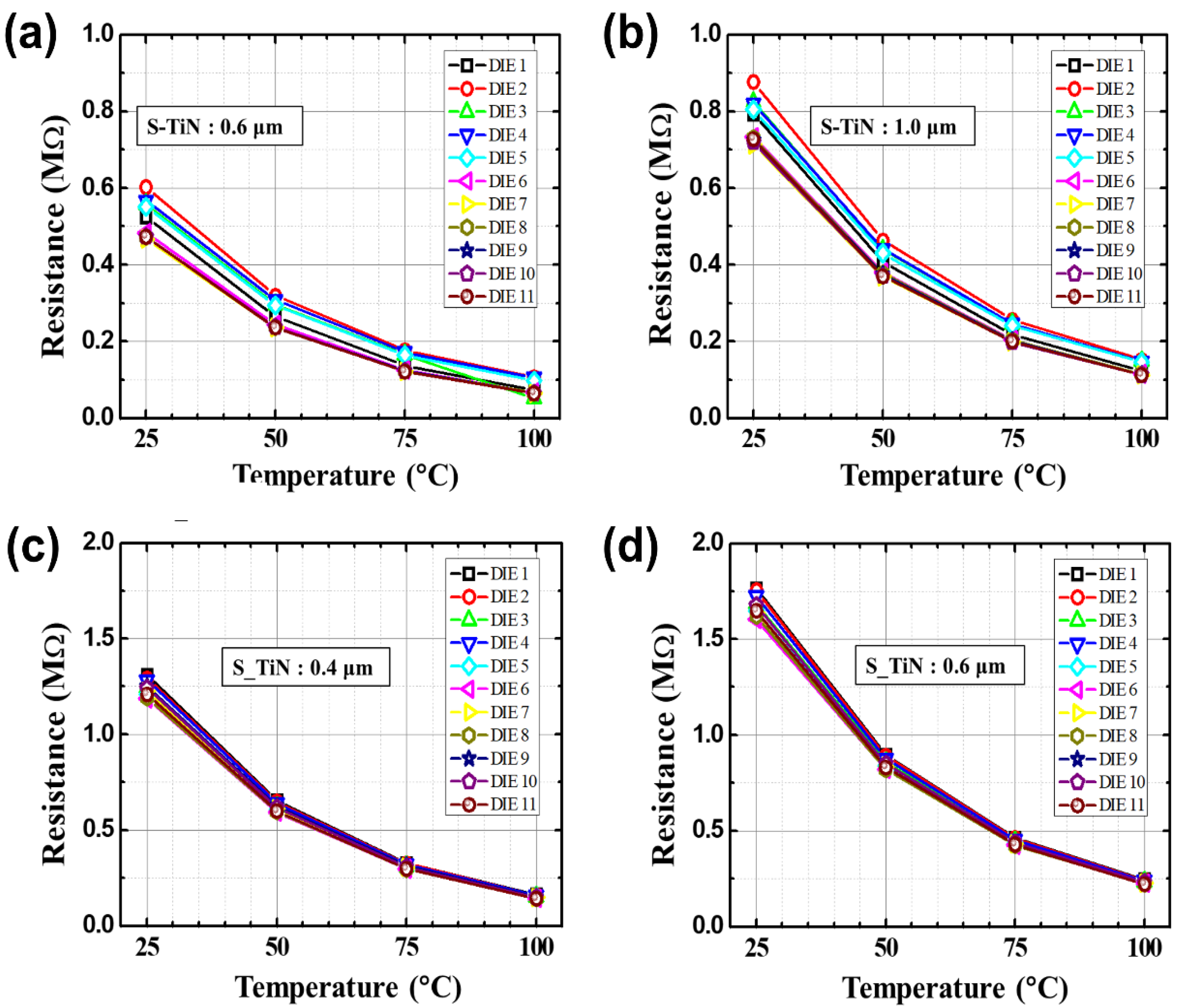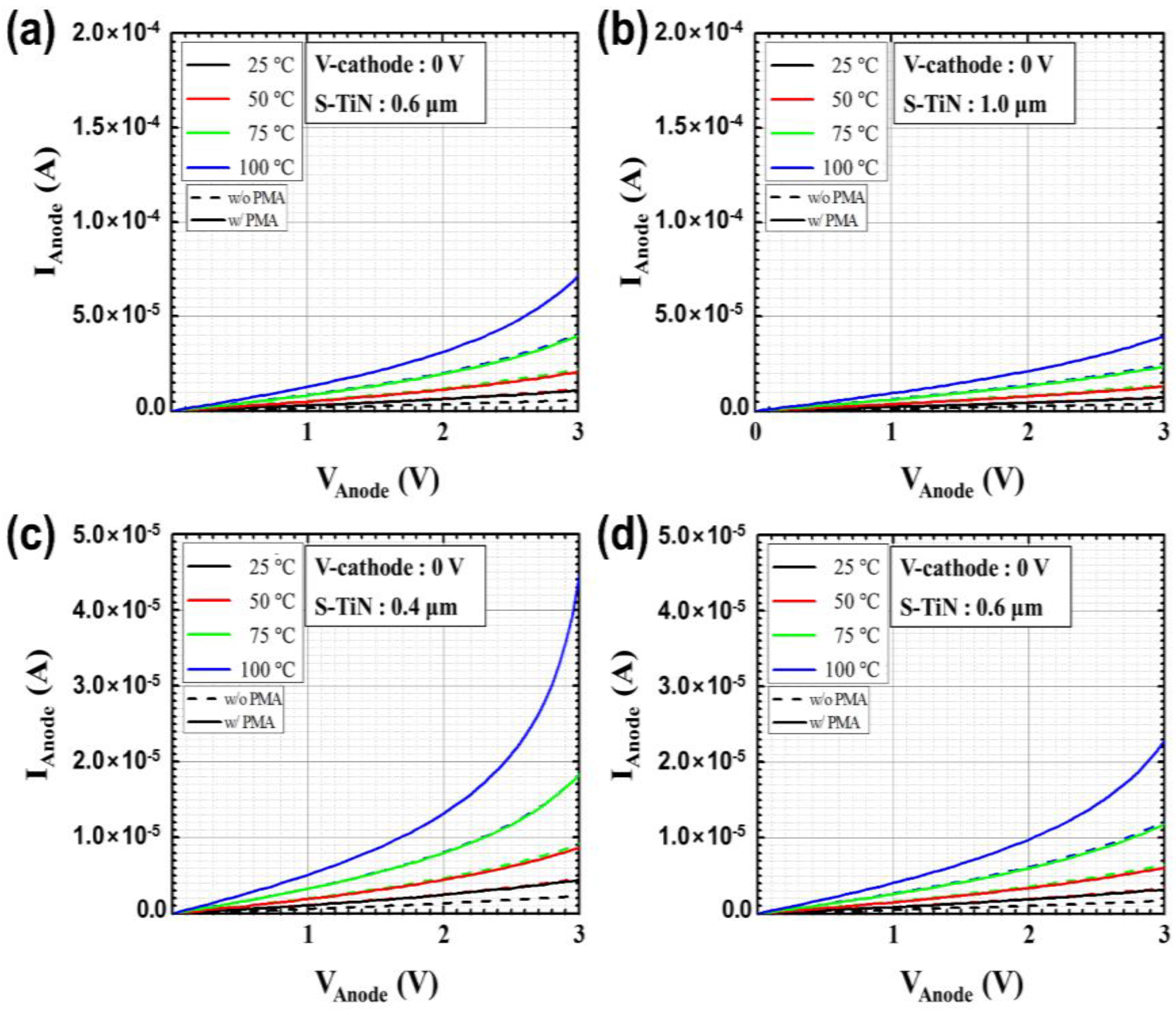Noise Improvement of a-Si Microbolometers by the Post-Metal Annealing Process
Abstract
1. Introduction
2. Experimental Section
2.1. Fabrication of a-Si Microbolometers
2.2. DC, TCR Measurements, and Noise Analysis
3. Results and Discussion
3.1. Electrical Characteristics of the a-Si Microbolometers before the PMA Process
3.2. Electrical Characteristics of the a-Si Microbolometers after the PMA Process
4. Conclusions
Author Contributions
Funding
Institutional Review Board Statement
Informed Consent Statement
Data Availability Statement
Acknowledgments
Conflicts of Interest
References
- Rogalski, A. Recent progress in infrared detector technologies. Infrared Phys. Technol. 2011, 54, 136–154. [Google Scholar] [CrossRef]
- Sundeen, J.E.; Buchanan, R.C. Thermal sensor properties of cermet resistor films on silicon substrates. Sens. Actuators A Phys. 2001, 90, 118–124. [Google Scholar] [CrossRef]
- Schaufelbuhl, A.; Schneeberger, N.; Munch, U.; Waelti, M.; Paul, O.; Brand, O.; Baltes, H.; Menolfi, C.; Huang, Q.; Doering, E.; et al. Uncooled low-cost thermal imager based on micromachined CMOS integrated sensor array. J. Microelectromech Syst. 2001, 10, 503–510. [Google Scholar] [CrossRef]
- Ogawa, S.; Okada, K.; Fukushima, N.; Kimata, M. Wavelength selective uncooled infrared sensor by plasmonics. Appl. Phys. Lett. 2012, 100, 021111. [Google Scholar] [CrossRef]
- Ganesan, S.; Maricot, S.; Robillard, J.-F.; Okada, E.; Bakouche, M.-T.; Hay, L.; Vilcot, J.-P. Plasmonic Layer as a Localized Temperature Control Element for Surface Plasmonic Resonance-Based Sensors. Sensors 2021, 21, 2035. [Google Scholar] [CrossRef]
- Bhan, R.K.; Saxena, R.S.; Jalwania, C.R.; Lomash, S.K. Uncooled Infrared Microbolometer Arrays and their Characterization Techniques. Def. Sci. J. 2009, 59, 580–589. [Google Scholar] [CrossRef]
- Niklaus, F.; Vieider, C.; Jakobsen, H. MEMS-based uncooled infrared bolometer arrays: A review. In Proceedings of the Photonics Asia 2007, Beijing, China, 11–15 November 2007. [Google Scholar]
- Tezcan, D.S.; Eminoglu, S.; Akin, T. A low-cost uncooled infrared microbolometer detector in standard CMOS technology. IEEE Trans. Electron Devices 2003, 50, 494–502. [Google Scholar] [CrossRef]
- Dao, T.D.; Doan, A.T.; Ishii, S.; Yokoyama, T.; Ørjan, H.S.; Ngo, D.H.; Ohki, T.; Ohi, A.; Wada, Y.; Niikura, C.; et al. MEMS-Based Wavelength-Selective Bolometers. Micromachines 2019, 10, 416. [Google Scholar] [CrossRef]
- Villa, E.; Arteaga-Marrero, N.; Ruiz-Alzola, J. Performance Assessment of Low-Cost Thermal Cameras for Medical Applications. Sensors 2020, 20, 1321. [Google Scholar] [CrossRef]
- Mounier, E. Technical and market trends for microbolometers for thermography and night vision. In Proceedings of the SPIE Defense, Security, and Sensing, Orlando, FL, USA, 25–29 April 2011. [Google Scholar]
- Gade, R.; Moeslund, T.B. Thermal cameras and applications: A survey. Mach. Vis. Appl. 2014, 25, 245–262. [Google Scholar] [CrossRef]
- Kylili, A.; Fokaides, P.A.; Christou, P.; Kalogirou, S.A. Infrared thermography (IRT) applications for building diagnostics: A review. Appl. Energy 2014, 134, 531–549. [Google Scholar] [CrossRef]
- Ring, E.F.J.; Ammer, K. Infrared thermal imaging in medicine. Physiol. Meas. 2012, 33, R33. [Google Scholar] [CrossRef]
- Park, S.; Cho, T.; Kim, M.; Park, H.; Lee, K. A shutter-less micro-bolometer thermal imaging system using multiple digital correlated double sampling for mobile applications. In Proceedings of the 2017 Symposium on VLSI Technology, Kyoto, Japan, 5–8 June 2017; pp. C154–C155. [Google Scholar]
- Shi, X.; Yu, S.; Chen, G.; Zhang, Y.; Cheng, Z.; Lu, W. A Low Noise 384 × 288 Uncooled Infrared Imager Based on Phase Difference Modulation. In Proceedings of the 2021 IEEE International Symposium on Circuits and Systems (ISCAS), Daegu, Korea, 22–28 May 2021; pp. 1–5. [Google Scholar]
- Yu, L.; Guo, Y.; Zhu, H.; Luo, M.; Han, P.; Ji, X. Low-Cost Microbolometer Type Infrared Detectors. Micromachines 2020, 11, 800. [Google Scholar] [CrossRef] [PubMed]
- Akin, T. Low-Cost LWIR-Band CMOS Infrared (CIR) Microbolometers for High Volume Applications. In Proceedings of the 2020 IEEE 33rd International Conference on Micro Electro Mechanical Systems (MEMS), Vancouver, BC, Canada, 18–22 January 2020; pp. 147–152. [Google Scholar]
- Lopes, V.C.; Syllaios, A.J.; Littler, C.L. Low frequency noise in hydrogenated p-type amorphous silicon thin films. J Non-Crys. Solid. 2017, 459, 176–183. [Google Scholar] [CrossRef]
- Pham, D.P.; Park, J.; Shin, C.; Kim, S.; Nam, Y.; Kim, G.; Kim, M.; Yi, J. Boron-doped hydrogenated mixed-phase silicon as thermo-sensing films for infrared detectors. Mater. Sci. Semicond. Process. 2018, 74, 165–169. [Google Scholar] [CrossRef]
- D’Amico, A.; Fortunato, G.; Van Vliet, C.M. Conductivity and noise in thin films of nonhydrogenated amorphous silicon in the hopping regime. Solid State Electron. 1985, 28, 837–8444. [Google Scholar] [CrossRef]
- Johanson, R.E.; Gunes, M.; Kasap, S.O. 1/f noise in hydrogenated amorphous silicon–germanium alloys. IEE Proc.-Circuits Devices Syst. 2003, 150, 345–349. [Google Scholar] [CrossRef][Green Version]
- Verleg, P.A.W.E.; Dijkhuis, J.I. Generation-recombination noise studied in hydrogenated amorphous silicon. J. Non-Cryst. Solids 1998, 227, 172–175. [Google Scholar] [CrossRef]
- Johanson, R.E.; Gunes, M.; Kasap, S.O. Noise in hydrogenated amorphous silicon. IET Circuits Devices Syst. 2002, 149, 68–74. [Google Scholar] [CrossRef]
- Saint John, D.B.; Shin, H.-B.; Lee, M.-Y.; Ajmera, S.K.; Syllaios, A.J.; Dickey, E.C.; Jackson, T.N.; Podraza, N.J. Influence of microstructure and composition on hydrogenated silicon thin film properties for uncooled micro bolometer applications. J. Appl. Phys. 2011, 110, 033714. [Google Scholar] [CrossRef]
- Weiler, D.; Hochschulz, F.; Busch, C.; Stein, M.; Michel, M.D.; Kuhl, A.; Lerch, R.; Petermann, M.; Geruschke, T.; Blaeser, S.; et al. Digital uncooled IRFPAs based on microbolometers with 17 μm and 12 μm pixel pitch. In Proceedings of the SPIE Security + Defence, Berlin, Germany, 10–13 September 2018. [Google Scholar]
- Sharma, P.; Dell, J.; Parish, G.; Keating, A. Engineering 1/f noise in porous silicon thin films for thermal sensing applications. Microporous Mesoporous Mater. 2021, 324, 111302. [Google Scholar] [CrossRef]
- Ketroussi, K.; Cherfi, R.; Seba, H.Y.; Tata, S.; Chabane, L.; Ozyuzer, L.; Rahal, A. Study of boron doped amorphous silicon lightly hydrogenated prepared by DC magnetron sputtering for infrared detectors applications. Infrared Phys. Technol. 2021, 113, 103556. [Google Scholar] [CrossRef]
- Shin, C.; Pham, D.P.; Park, J.; Kim, S.; Lee, Y.-J.; Yi, J. Structure and electrical properties of boron doped hydrogenated mixed-phase silicon films for uncooled microbolometer. Infrared Phys. Technol. 2019, 96, 84–88. [Google Scholar] [CrossRef]
- Seager, C.H.; Ginley, D.S. Passivation of grain boundaries in polycrystalline silicon. Appl. Phys. Lett. 1979, 34, 337–340. [Google Scholar] [CrossRef]
- Johnson, N.M.; Biegelsen, D.K.; Moyer, M.D. Deuterium passivation of grain boundary dangling bonds in silicon thin films. Appl. Phys. Lett. 1982, 40, 882–884. [Google Scholar] [CrossRef]













| Temperature | P35-S06 | P35-S10 | P12-S04 | P12-S06 |
|---|---|---|---|---|
| 25 °C | 5.72 × 10−6 A | 3.79 × 10−6 A | 2.29 × 10−6 A | 1.70 × 10−6 A |
| 50 °C | 1.13 × 10−5 A | 7.36 × 10−6 A | 4.57 × 10−6 A | 3.35 × 10−6 A |
| 75 °C | 2.20 × 10−5 A | 1.38 × 10−5 A | 9.14 × 10−6 A | 6.46 × 10−6 A |
| 100 °C | 4.09 × 10−5 A | 2.44 × 10−5 A | 1.84 × 10−5 A | 1.22 × 10−5 A |
| P35-S06 | P35-S10 | P12-S04 | P12-S06 | |
|---|---|---|---|---|
| TCR (%/°C) | −2.63 | −2.46 | −2.81 | −2.63 |
| P35-S06 | P35-S10 | P12-S04 | P12-S06 | |
|---|---|---|---|---|
| SIaonde/Ianode2 (1/Hz) | 4.44 × 10−11 | 3.32 × 10−11 | 1.56 × 10−10 | 1.21 × 10−10 |
| P35-S06 | P35-S10 | P12-S04 | P12-S06 | |
|---|---|---|---|---|
| TCR (%/°C) | −2.46 | −2.37 | −3.54 | −2.76 |
| Increase rates w.r.t reference | 6.28% | 4.18% | 26.3% | 4.94% |
| P35-S06 | P35-S10 | P12-S04 | P12-S06 | |
|---|---|---|---|---|
| Noise level at 10 Hz (1/Hz) | 3.36 × 10−11 | 2.16 × 10−11 | 1.42 × 10−10 | 1.13 × 10−10 |
| Decrease rates w.r.t reference | −48.2% | −46.4% | −23.7% | −6.34% |
Publisher’s Note: MDPI stays neutral with regard to jurisdictional claims in published maps and institutional affiliations. |
© 2021 by the authors. Licensee MDPI, Basel, Switzerland. This article is an open access article distributed under the terms and conditions of the Creative Commons Attribution (CC BY) license (https://creativecommons.org/licenses/by/4.0/).
Share and Cite
Oh, J.; Song, H.-s.; Park, J.; Lee, J.-K. Noise Improvement of a-Si Microbolometers by the Post-Metal Annealing Process. Sensors 2021, 21, 6722. https://doi.org/10.3390/s21206722
Oh J, Song H-s, Park J, Lee J-K. Noise Improvement of a-Si Microbolometers by the Post-Metal Annealing Process. Sensors. 2021; 21(20):6722. https://doi.org/10.3390/s21206722
Chicago/Turabian StyleOh, Jaesub, Hyeong-sub Song, Jongcheol Park, and Jong-Kwon Lee. 2021. "Noise Improvement of a-Si Microbolometers by the Post-Metal Annealing Process" Sensors 21, no. 20: 6722. https://doi.org/10.3390/s21206722
APA StyleOh, J., Song, H.-s., Park, J., & Lee, J.-K. (2021). Noise Improvement of a-Si Microbolometers by the Post-Metal Annealing Process. Sensors, 21(20), 6722. https://doi.org/10.3390/s21206722







